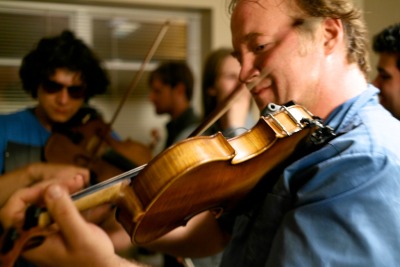Adapted from a presentation by Christian Howes (founder of Creative Strings) at the 2021 American String Teachers Association National Conference. You can view the original presentation, which includes Parts 1, 2 and 3, of this series on Teaching Improvisation and Harmony- plus interactive play-along sections, below.
Creative Improvisation versus Applied Harmony Revisited
In part one of this series on teaching improvisation and harmony, I shared with you my belief that creative improvisation and applied harmony can and should be taught as two separate topics pedagogically.
I also believe that the frequent failure to present these two areas as two separate topics is what can make improvised music so overwhelming, or intimidating, or confusing for classically trained students. Because when we teach harmony and creativity together as a single entity, we’re asking them to create with a set of tools that they’re not comfortable with- and then, when they get discouraged, they assume that it’s their creativity that’s lacking- when really, it’s their harmonic knowledge.
And that’s why I find the two creative improvisation exercises that I previously shared with you (my Creative Improvisation Icebreaker and my Creative Improvisation Free Association Exercise) so powerful- because it proves to students that they are creative. That they can succeed and create something right now, no matter what their playing ability on their violin, viola, cello, or bass. And once they know that we can focus on the part that most classically trained string players actually struggle with- applied harmony.
So today, in this third and final part, I’m going to share with you an exercise that you can use in your string classroom that focuses on the other branch- applied harmony.
If you’d like to watch and listen to me demonstrate this harmony exercise on violin instead of reading, you can view this part of the video above starting around 23:20.
There’s also a second exercise in the video above at around 30:00 that I use to help students internalize harmony- it uses a tool that I call “chord stacks” on Pachelbel’s Canon. Chord stack diagrams are like a set of training wheels for your string students- they allow them to visually see all the safe note choices that they have over a given chord without needing to have their chord spellings memorized right away. Instead, they simply pick one or more of the notes from the page in front of them. Again, like dividing up harmony and creative improvisation, this helps students learn by breaking things down into smaller parts. Instead of requiring students to memorize AND play harmony at the same time, they can focus on playing and memorizing separately.
Since it requires a visual aid handout, I decided not to include the second exercise in written form here, but if you’re interested in that exercise, feel free to check either the Easy Tonal Improv Workbook or Easy Tonal Improv Multimedia Course in my eShop.
Or get a free preview of all my best tonal harmony resources when you sign up for my mailing list below. You’ll get a copy of the “chord stacks” as one of your first freebies. (Then you can return here and do the exercise with me!)
How to Really Internalize A Scale
When I start teaching students about harmony, I always begin with a single scale.
To make that work, as a teacher I have to choose a chord progression that stays in one key, so that you can get away with playing a single scale the whole time. Of course, you can’t do that over every progression- but I always pick a progression where I know that will work. (I do this a lot on my YouTube channel when choosing chord progressions to make play-along lessons for too. You can check out my channel here).
(For example- the progression I use in the video is B minor, G major, A major, and E minor- or the iv, IV, V, ii of D major in classical theory terms. That way I can play the D major scale over all of it)
And then I’ll tell students to write down the key signature for themselves on the page. Because whenever we look at music in orchestra we look at the key signature and then we apply ABCDEFG to that key signature.
(So, for D major, they would right down the key signature of F# and C#, making the notes that we’re using the notes A B C# D E F# G.)
Now what you want your students to be able to do in order to internalize this scale is to play all its notes everywhere in first position on the violin, viola, cello, or bass.
In other words, for D major:
- violinists should eventually be able to play all the way from their open G string up to the A (or B) on their E string
- violists or cellists should eventually be able to start from the C# low one on their C string and play all the way up to D (or E) on their A string.
- bassists, would go roughly from their open E up to B on their G string (of course, bass fingering being very different, you might have to adapt the exercise further too)
But to really break it up and internalize it, I don’t just run the scale from the bottom all the way to the top like that. I play simple patterns like, for example one octave at a time.
So, for example in the video around [timestamp] I play:
- G to G (G A B C# D E F# G)
- A to A (A B C# D E F# G A)
- B to B (B C# D E F# G A B)
- etc. etc.
And then eventually I reverse things and go the opposite direction.
Then I do a three-note pattern where I skip every other note- kind of like skipping the even numbers in a numeric sequence. So instead of doing 1 2 3 4 5, we just do 1 3 5:
- G B D
- A C# E
- B D F#
And that’s all that I’m doing- sequences. It’s not that different from a sequence that is often asked on standardized tests- like “complete the sequence”, except with notes instead of numbers.
And there are hundreds of these patterns that you can do (of course, you wouldn’t expect a sixth-grader to actually do all of them- but it’s just an aspirational thing that eventually they, or maybe yourself as the teacher, could do). Intervals and double-stops too.
And you can apply them to other scales too eventually. And the more your students play them, the more they internalize the scale in a functional way. They take it from being a slow-thinking thing for themselves to a fast-thinking thing- and then they can go back and use it during creative improvisation because now it is something that they’re already familiar with.
You can also check out my scales book in my eStore or this video on how to practice scales effectively for more examples.


